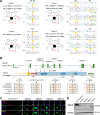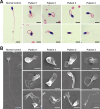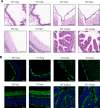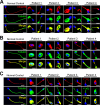DNAH3 deficiency causes flagellar inner dynein arm loss and male infertility in humans and mice
- PMID: 39503742
- PMCID: PMC11540302
- DOI: 10.7554/eLife.96755
DNAH3 deficiency causes flagellar inner dynein arm loss and male infertility in humans and mice
Abstract
Axonemal protein complexes, including the outer and inner dynein arms (ODA/IDA), are highly ordered structures of the sperm flagella that drive sperm motility. Deficiencies in several axonemal proteins have been associated with male infertility, which is characterized by asthenozoospermia or asthenoteratozoospermia. Dynein axonemal heavy chain 3 (DNAH3) resides in the IDA and is highly expressed in the testis. However, the relationship between DNAH3 and male infertility is still unclear. Herein, we identified biallelic variants of DNAH3 in four unrelated Han Chinese infertile men with asthenoteratozoospermia through whole-exome sequencing (WES). These variants contributed to deficient DNAH3 expression in the patients' sperm flagella. Importantly, the patients represented the anomalous sperm flagellar morphology, and the flagellar ultrastructure was severely disrupted. Intriguingly, Dnah3 knockout (KO) male mice were also infertile, especially showing the severe reduction in sperm movement with the abnormal IDA and mitochondrion structure. Mechanically, nonfunctional DNAH3 expression resulted in decreased expression of IDA-associated proteins in the spermatozoa flagella of patients and KO mice, including DNAH1, DNAH6, and DNALI1, the deletion of which has been involved in disruption of sperm motility. Moreover, the infertility of patients with DNAH3 variants and Dnah3 KO mice could be rescued by intracytoplasmic sperm injection (ICSI) treatment. Our findings indicated that DNAH3 is a novel pathogenic gene for asthenoteratozoospermia and may further contribute to the diagnosis, genetic counseling, and prognosis of male infertility.
Keywords: DNAH3; asthenoteratozoospermia; genetics; genomics; human; inner dynein arm; male infertility; mouse.
© 2024, Wang, Shen, Yang et al.
Conflict of interest statement
XW, GS, YY, CJ, TR, XY, LZ, YZ, YO, XZ, SL, XT, TL, YS No competing interests declared
Figures

















Update of
- doi: 10.1101/2024.02.19.580977
- doi: 10.7554/eLife.96755.1
- doi: 10.7554/eLife.96755.2
- doi: 10.7554/eLife.96755.3
Similar articles
-
DNALI1 deficiency causes male infertility with severe asthenozoospermia in humans and mice by disrupting the assembly of the flagellar inner dynein arms and fibrous sheath.Cell Death Dis. 2023 Feb 15;14(2):127. doi: 10.1038/s41419-023-05653-y. Cell Death Dis. 2023. PMID: 36792588 Free PMC article.
-
Association of novel DNAH11 variants with asthenoteratozoospermia lead to male infertility.Hum Genomics. 2024 Sep 11;18(1):97. doi: 10.1186/s40246-024-00658-w. Hum Genomics. 2024. PMID: 39256880 Free PMC article.
-
Deficiency in DNAH12 causes male infertility by impairing DNAH1 and DNALI1 recruitment in humans and mice.Elife. 2025 Mar 27;13:RP100350. doi: 10.7554/eLife.100350. Elife. 2025. PMID: 40146200 Free PMC article.
-
Insight on multiple morphological abnormalities of sperm flagella in male infertility: what is new?Asian J Androl. 2020 May-Jun;22(3):236-245. doi: 10.4103/aja.aja_53_19. Asian J Androl. 2020. PMID: 31210147 Free PMC article. Review.
-
A novel variant in CFAP69 causes asthenoteratozoospermia with treatable ART outcomes and a literature review.J Assist Reprod Genet. 2023 Sep;40(9):2175-2184. doi: 10.1007/s10815-023-02873-1. Epub 2023 Jul 1. J Assist Reprod Genet. 2023. PMID: 37392306 Free PMC article. Review.
Cited by
-
Function of manchette and intra-manchette transport in spermatogenesis and male fertility.Cell Commun Signal. 2025 May 29;23(1):250. doi: 10.1186/s12964-025-02213-z. Cell Commun Signal. 2025. PMID: 40442757 Free PMC article. Review.
-
Genetic variants in QRICH2 gene among Jordanians with sperm motility disorders.Libyan J Med. 2025 Dec;20(1):2481741. doi: 10.1080/19932820.2025.2481741. Epub 2025 Mar 19. Libyan J Med. 2025. PMID: 40107860 Free PMC article.
References
-
- Aprea I, Raidt J, Höben IM, Loges NT, Nöthe-Menchen T, Pennekamp P, Olbrich H, Kaiser T, Biebach L, Tüttelmann F, Horvath J, Schubert M, Krallmann C, Kliesch S, Omran H. Defects in the cytoplasmic assembly of axonemal dynein arms cause morphological abnormalities and dysmotility in sperm cells leading to male infertility. PLOS Genetics. 2021;17:e1009306. doi: 10.1371/journal.pgen.1009306. - DOI - PMC - PubMed
-
- Ben Khelifa M, Coutton C, Zouari R, Karaouzène T, Rendu J, Bidart M, Yassine S, Pierre V, Delaroche J, Hennebicq S, Grunwald D, Escalier D, Pernet-Gallay K, Jouk P-S, Thierry-Mieg N, Touré A, Arnoult C, Ray PF. Mutations in DNAH1, which encodes an inner arm heavy chain dynein, lead to male infertility from multiple morphological abnormalities of the sperm flagella. American Journal of Human Genetics. 2014;94:95–104. doi: 10.1016/j.ajhg.2013.11.017. - DOI - PMC - PubMed
MeSH terms
Substances
Grants and funding
LinkOut - more resources
Full Text Sources
Medical
Molecular Biology Databases
Research Materials

